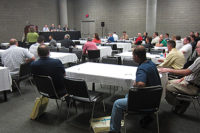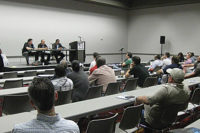One of the best-attended events for fabricators at the Coverings event is the Fabricator Forum, where stoneworking professionals from around the country discuss their current issues — and solutions — with a panel of experts. This year’s Fabricator Forum saw higher attendance than it has in years, and a range of topics were addressed. Panelists at the forum included:
• Joey Marcella, Mario & Son, Liberty Lake, WA
• Matt Laliberti, Ripano Stoneworks Ltd., Nashua, NH
• Tony Malisani, Malisani, Inc., Great Falls, MT
• G.K. Naquin, Stone Interiors, Loxley, AL (moderator)
Are you having problems with resin-treated or dyed slabs?
Malisani: We received some Emperador Dark that didn’t look quite right. It didn’t polish right, and when we put it on the radial arm polisher, we found that it had been stained to be darker. We polished it up to match it.
Marco Duran, Atlas Granite and Marble (audience member): We are seeing that for pretty much all of our exotics. Akemi has a color kit with a sealer that works.
Laliberti: We use Tenax Ager and also Tepox V, and it comes in different colors. You just need to mix a little in with the Ager. We do a light coat on the first application, so it is easier to do a second application. It is a permanent solution.
Is anyone seeing UV issues with resin-treated slabs where they are turning yellow?
Laliberti: We had that with some Siena Bordeaux. Five of the six slabs were fine, but the sixth was yellow. Our shop has indoor storage, so we just sent it back.
Naquin: It really is advisable to store any resin-treated slab inside.
How are fabricators marketing themselves on the Web?
Laliberti: It seems like the rules of search engine optimization change every day. Google has some bizarre rules on what to do and not do on your site, so we hired a consultant.
Social media has also been successful for us. We encourage customers to “like” us after a job, and when people see the testimonials on us on Facebook, they know it is the real deal.
Marcella: We have 1,300 fans on Facebook right now. We were reluctant at first, and we thought it was a fad, but now we have embraced it.
Some shops only put their jobs on Facebook, but we try to let people get more into our business and what we do. We’ve actually gotten employees and jobs from it, and there is no cost.
Malisani: It is also important to remember that with Facebook and the Internet out there, if you have unhappy customers, you have to take care of it. People are prone to post when they are unhappy, and you need to know what people are saying about you.
We put our family history on our Web site. We tell them about our involvement with Habitat for Humanity and such. People want to get to know you so that they can have a sense of you before they walk in the door. You welcome people by letting them become familiar with you.
This is why the Big Boxes are popular. They are already familiar to people.
Marcella: You are able to answer your critics on Facebook. Very often, reviews on Google cannot be responded to professionally, but Facebook allows you to do that.
What do you do when your customer only wants cheap prices? At the local Lowe’s in my area, they are charging $29 per square foot.
Marcella: We do Big Box stores, but in our region, it is $59 per square foot. They set the market for us. We work with 14 Home Depots and two Lowe’s locations, and we also do blanks, which we don’t love, but we have to do it. They are only $39 per square foot, but the customers still expect all of the bells and whistles.
If I were a fabricator not doing work for Big Boxes, I would sell my expertise and communicate how what I do is better.
Malisani: We sell service. We work with a lot of kitchen and bath dealers, and we turn around our estimates quickly. A good first impression is important, but you need to follow through on that throughout the entire process. Our education sales reps can answer all questions from the customer.
The Big Box advantage is size and scope. We have a program for retail dealers, and we are not cheaper, but we try and provide a higher level of service. You don’t need to be the lowest price.
Naquin: The Big Boxes charge $39 per square foot in my market. Many of the Big Box fabricators are good quality, but the associates in the store may not be as well versed as your own sales staff.
Malisani: We want to be in front of the customer first. When someone decides to remodel, where do they go? To the Internet. We knew that we needed a presence there.
In general, we give customers too much credit for over-shopping. People buy where they are comfortable, and we need to be responsive to the customers.
What do you do when customer expectations are super high?
Marcella: Some of the smaller shops seem to overstate what is possible in stonework. People are talking about seams that are “nearly invisible,” but those tend to be the shops doing one kitchen per week. This wasn’t a problem five years ago, but now smaller shops are offering those types of seams. Once they expand to around seven to 10 kitchens per week, they won’t be able to do it.
Naquin: That’s how the promise of free sinks came out.
Marcella: We have a nice showroom, but intentionally, the work that we have in there is average. We want to under-promise and over-deliver. A lot of shops promise the world, and maybe they can do that at one kitchen per week or when the owner is on every job.
So volume makes a difference in service?
Marcella: When we started, it was just me and my dad. Now we have 40 employees, and we have to rely on them, but it is always different than having the owner there. We were forced to grow based on demand, and we learned to adjust based on that.
Audience Member: When customers come into your shop with a Home Depot price, you need to decide whether you are supplying a commodity or if you are supplying craftsmanship.
Laliberti: When someone comes into our shop and wants $40 per square foot, they probably won’t be our customer. We don’t sell on price. We have a digital shop, and we walk the customer through. Once they see our operation, price becomes less of an issue.
We have a good reputation, and we work hard to maintain it even if that means doing things that we know are not right. There is a fine line between customer education and discouraging them from using stone. People stare at a slab and say that it is beautiful, but then you install it and they say, “Whoa, look at these pits and fissures.” That’s why you need education about fissures right up front.









